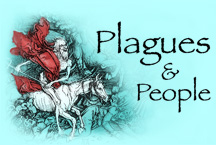
Infectious and Epidemic Disease in History
Department of History
University of California, Irvine
Instructor: Dr. Barbara J. Becker

Department of History
University of California, Irvine
Instructor: Dr. Barbara J. Becker
Supplementary readings for Week 9's lectures include excerpts
from:
At the start of the Great War in 1914, the world's death rate had been steadily declining for over a century and a half, thanks to improved nutrition and sanitation, the introduction of vaccination against smallpox, the discovery of microbes responsible for many common life-threatening epidemic diseases, the development of sera specific to these diseases, and the establishment of regional health regulatory agencies. In 1918, that trend was dramatically reversed, not by the War's senseless carnage, but by an epidemic like none the world had known since the Black Death of the 14th century. In twelve months, the disease some called the "Spanish Influenza" killed over a half-million people in the United States, and -- it is estimated -- over 40 million globally. In December 2003, avian flu killed 19,000 chickens near Seoul, Korea. Similar outbreaks have since been reported in neighboring Vietnam, Thailand, and Cambodia. Like other viruses of its kind, this one rapidly mutated to a form infectious to humans. Between January 2004 and May 2005, it infected 97 people in the region, of whom 53 (over half) died. Viet Nam was the most severely affected with 76 cases and 37 deaths. Human victims became ill through direct contact with infected birds, but there was evidence that at least one case resulted from human to human transfer. By August 2005, the strain had spread to poultry in both Russia and Kazakhstan and deaths of migratory birds had been observed in Mongolia. Click here to find the latest reports on avian influenza from the World Health Organization.
|
 |
| Go to: |
|